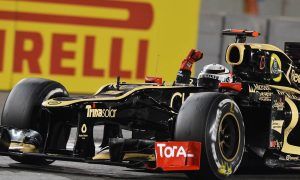
©XPB Images
“LIKE A RABBIT IN THE HEADLIGHTS OF A CAR”
“There’s good and bad parts to it. I had only been in Formula 1 for seven years. I had come from junior engineer to technical director, so it was a very rapid kind of process. Whilst the challenge was fantastic, and you have to take opportunities like that whenever they come along, you are sort of not prepared for it, particularly when you’ve only done seven years or seven seasons.
“It is little bit like [being] a rabbit in the headlights of a car on the road. But if you have got a vision of what you are trying to achieve, and if you have got that sort of passion and motivation, wherever the team is at the time to move it forwards, with all the people around you, then I think you quickly settle down and you establish your way of working. So, yes, it was a challenge, but it was this challenge every year. I think it was good to do it then actually, to make that transition early you learn a hell of a lot.”
While the team’s identity kept changing – from Midland to Spyker in 2007 and finally Force India one year later –, Key stayed put and worked wonders with meagre financial resources. In 2009, Giancarlo Fisichella claimed a stunning pole position at the Belgian Grand Prix and came close to winning the race with the unfancied VJM02, only beaten by Kimi Raikkonen’s KERS-aided Ferrari.
In April 2010, Peter Sauber hired Key to lead Hinwill’s technical department and supervise his team’s restructuring after BMW’s departure. The task proved to be challenging and it was said that conflicting views between Key and Sauber led to the Briton’s premature exit from the Swiss outfit.
If his input on the 2011 challenger remained limited, Key’s Sauber brainchild – the 2012-spec C31 – would be the team’s most successful car in terms of podium finishes with four in the hands of Sergio Perez and Kamui Kobayashi. Following rumours of his return to Lotus to work on endurance and GT programmes, Key eventually joined Toro Rosso.

©XPB Images & Wri2
THE KEY TO SUCCESS?
Having moved to Faenza, on the outskirts of Modena, with his wife and their three children in tow, this workaholic strove to overhaul selected areas of the team all the while strengthening others. Under his stewardship, Force India, Sauber, and Toro Rosso have all moved up the pecking order in the Constructors’ championship: all three teams have had limited budgets; they are based in different countries and feature equally diverse corporate cultures.
It should not come as a surprise therefore to see Key emerge as one of the most respected technical figures in the paddock, nor to hear his name linked to Ferrari in the wake of James Allison’s departure and then to Williams following Pat Symonds’ exit. So is there a trademark Key method for winning?
“I think it is a real mix. I think all technical directors work differently; we have different experiences. We all have the same target but it is done in different ways.
“I think a lot of it is really understanding what you are trying to achieve and how you get that. It is not necessarily the details of what the front wing needs to look like. Or the details of how the compression in the engine is working. You need to be aware of a lot of that, and of course you have your areas of expertise as well, but you have got to be able to step back and see the bigger picture.
“You think: ‘I have got a bit of a feeling for where we are here, I can understand the strengths and weaknesses of the team. This area I need to be very hands-on because it’s an area we need to push and could be critical. This area seems to be right, so I will leave that – you know, with close collaboration – to whoever runs that area.
“As technical director, I think it makes sense to adjust the way you operate to match the existing strengths within a team and then get on with attacking the weaknesses, rather than change the whole structure according to what you are used to.
“For example, we created a performance department, with a big restructuring, we significantly increased the resources in aero, which needed new departments, we changed the culture of the design office completely to ensure that we were performance-based.
“If you can build up the team to a level where you have got all of these areas about balanced for the size of the team, all operating within the vision that you have got in your mind to make the team step forward, I think you are there. That is kind of how it is now. But it varies dramatically from one department to another, from one individual to another, as to how hands-on you have to be with a given technical challenge.
“My role is a real mix of a lot of concentration on a given area from my side, for example sitting down with chief designers to go through solutions that allow us to develop maximum aero on the car, or just taking a slight step back and checking that another area is working as you’d expect.
“At the end of the day, no one person can design the car now, it is so complex: it is a group effort. But someone needs to give a direction. Say we’ve got direction A and direction B. One is going to be better than the other, and it is difficult to predict which one. But my job is to say which one we are going to go with.”






